Establishing a human settlement on Mars has been the fevered dream of space agencies for some time. Long before NASA announced its “Journey to Mars” – a plan that outlined the steps that need to be taken to mount a manned mission by the 2030s – the agency’s was planning how a crewed mission could lead to the establishing of stations on the planet’s surface. And it seems that in the coming decades, this could finally become a reality.
But when it comes to establishing a permanent colony – another point of interest when it comes to Mars missions – the coming decades might be a bit too soon. Such was the message during a recent colloquium hosted by NASA’s Future In-Space Operations (FISO) working group. Titled “Selecting a Landing Site for Humans on Mars”, this presentation set out the goals for NASA’s manned mission in the coming decades.
Established in 2006 by the then-active FISO Working Group, the FISO lecture series is intended as an innovative outreach effort, helping leaders in the fields of science, technology, engineering and space exploration connect with the public. Held on March 16th, the colloquium touched on a number of issues which were raised at the the First Landing Site/Exploration Zone Workshop for Human Missions to the Surface of Mars – which took place in October of 2015 at the Lunar Planetary Institute (LPI) in Houston, TX.
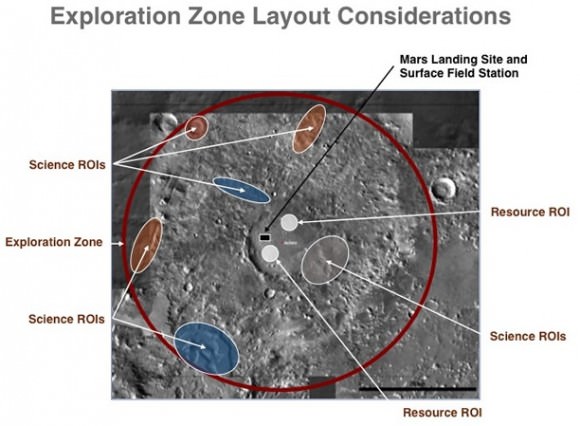
Presented by Dr. Ben Bussey of NASA’s Human Exploration and Operations Mission Directorate (HEOMD) ) and Rick Davis of NASA’s Science Mission Directorate (SMD), the colloquium and Houston workshop that preceded it were both focused on NASA’s plans for a crewed mission to Mars, and the creation of possible Exploration Zones (EZ) on the planet’s surface.
Prior to becoming the chief exploration scientist at HEOMD, Dr. Bussey served as the Group Supervisor of the planetary exploration group at John Hopkins University Applied Physics Laboratory and was also the Principle Investigator (PI) of the Volatile Regolith Thermal Investigations Consortium for Exploration & Science (VORTICES) team at NASA’s Solar System Exploration Research Virtual Institute (SSERVI).
Dr. Davis, meanwhile, worked at the Johnson Space Center and held numerous positions in the Flight Operations Directorate before becoming the Assistant Director for science and exploration at the SMD. He’s also had extensive international experience with the ISS, which included serving as the Space Station Capsule Communicator (CAPCOM) for the Expedition 13 mission and Space Shuttle Mission, STS 119. Prior to this, he worked as the Deputy Director of NASA Operations in Star City, Russia.
As such, both men are highly qualified in their respective fields and have much to offer when it comes to the subject of planetary exploration. And when it comes to NASA’s proposed manned mission of Mars, both have been highly involved in the ongoing process of evaluating potential landing sites, as well as the creation of potential EZs.
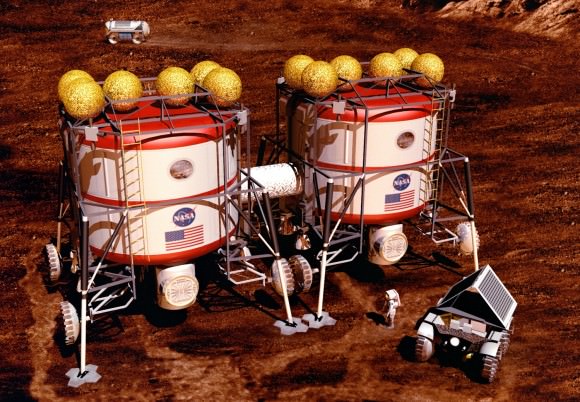
Put simply, an EZ is a zone that extend up to 100 km in all directions around a landing site, and which contains multiple Regions of Interest (ROIs). Other spots within an EZ include a landing spot for the mission spacecraft, a science site to conduct research, and a habitation site where the astronauts will erect living quarters. Such a site will be necessary for the development of capabilities and resources that would allow us to maintain a human presence on Mars.
Currently, NASA has 45 of these zones mapped out, which will be examined by the HEOMD and the SMD as part of the multi-year process of determining where and how humans, and not robotic missions, will explore Mars. But, as was indicated during the course of the presentation, any bases built on the Martian surface would be strictly temporary.
As Assistant-Director Richard Davis explained to Universe Today via email:
“The Exploration Zone is really a critical concept for enabling human exploration of Mars. It is fundamentally about setting up a semi-permanent base much like we did with the McMurdo Research Station in Antarctica or even the International Space Station. Such a semi-permanent research base is key because we can incrementally build up our presence on Mars…including living and research modules, rovers and a whole range of machinery / robots to support the humans. We can also stockpile food and other consumables, as well as spare parts. This ability to stockpile needed items has proven invaluable onboard ISS and effectively represents a massive insurance policy should anything go wrong. Essentially, we would be building to a sustainable presence. It’s not a colony because it probably will not permanently occupied initially. But it’s a critical foothold on another planet–which frankly would be an evolutionary first!”
While the establishment of an EZ would involve the creation of a habitation site that would serve as a base for multiple crewed missions, said crews would only be there on a temporary and rotating basis. A permanent settlement, in which humans landed on Mars and remained there indefinitely, is simply not on the books, as far as NASA’s plans for a manned-mission are concerned.
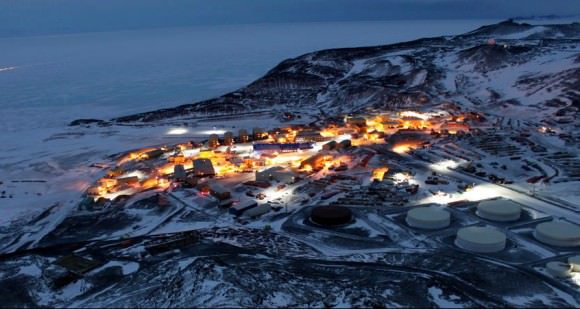
Or, as Dr. Bussey was quoted as saying by Space.com, a Mars colony is “a long way down the road. No one’s thinking of, on the NASA side, like a permanent human base. The idea here is that you would have your exploration zone that you set up for the first crew. And that crew would leave, and then you send another crew at the next good launch opportunity. So it isn’t permanently occupied, but it is visited multiple times.”
“If we choose the base location well,” Davis added, “it will have access to highly diverse and exciting science regions of interest–to take full advantage of having creative and adaptive humans beings on the planet to achieve revolutionary gains in science. It will also have access to critical resources such as water to sustain the human explorers and to reduce overall mission costs. When this would evolve into a more robust colony is unclear. But the foothold makes that vision much more achievable. If anything I would focus on the foothold… if we get that, I am pretty sure the colony will follow!”
In short, a temporary base would be a major step in the direction of a permanent one. As already noted, a Martian habitation site would be analogous to an existing research station here on Earth – the McMurdo Naval Air Facility in Antarctica. Established in 1955 as part of “Operation Deep Freeze” – a US effort to explore the South Pole – this collection of semi-permanent structures became the basis of an enduring human presence in the Antarctic.
Today, McMurdo is Antarctica’s largest community, boasting a functional and modern science station, a harbor, three airfields, a heliport, and more than 100 permanent buildings. Because of this, the very words “Operation Deep Freeze” have come to be synonymous with the creation of an enduring presence in Antarctica – which is similar in many ways to the Martian environment (i.e. very cold and inhospitable!). Little wonder then why NASA chose it as a model for humanity’s planned Martian presence, which they hopes will serve as framework for a lasting human presence.
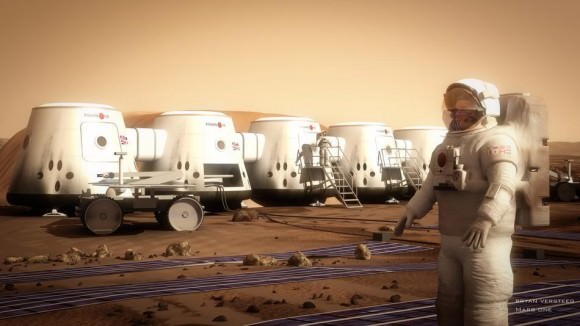
Naturally, it will likely be several years before an EZ site is selected. And before that can happen, NASA plans to map out Mars’ deposits of surface ice extensively. Any site selected for a crewed mission will need to have sufficient resources to sustain a habitat, the most important of which is a sufficient source of water. This surveying may also require that another orbital mission be launched to map out the surface in greater detail.
And while NASA may see a permanent settlement as a far-off prospect, there are also several private ventures that are lookingto colonize Mars in the near-future. Elon Musk has made it clear that he intends to build a Martian colony with a population of about 80,000 in the coming decades. He has also indicated that in addition to reusable rocket systems, SpaceX is working on a Mars Colonial Transporter, a vessel that will be able to shuttle 100 citizens to Mars at a time (for $500,000 a pop).
MarsOne, the Netherlands-based crowdsourced space venture, is also still trying to send volunteer astronauts on a one-way trip to Mars (starting in 2026) with the intention of creating a permanent settlement there. While there is plenty of doubt that this mission will take place within the time frames specified, or whether the first wave of colonists will even survive, MarsOne founder Bas Landorp remains committed to seeing it through.
Other ventures include Inspiration Mars, a private space venture started by engineer and multimillionaire Dennis Tito for the sake of sending a couple on flyby of the planet. With the help of The Mars Society – the world’s largest advocacy organization for promoting the human exploration and settlement of Mars – the organization held a design competition in February of 2014 that saw 38 participated teams compete to see who’s spaceship design would be the one to make the trip.
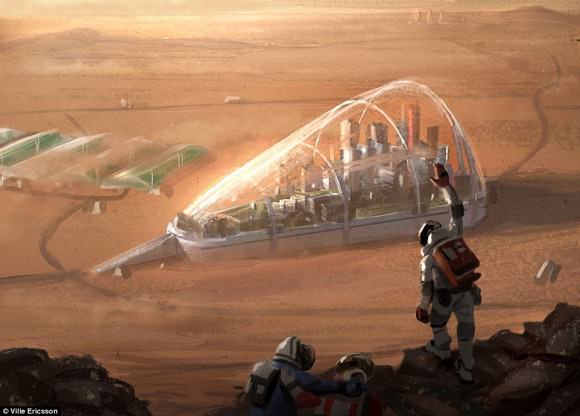
And NASA is by no means the only space agency that is looking to Mars as the future of its exploration efforts. Since 2001, the ESA has been contemplating a manned mission to Mars, one which was originally proposed to take place by 2033. In 2011, Roscosmos and the ESA completed the ground-based MARS-500 – a biomedical experiment simulating manned flight to Mars that is part of a proposed joint-venture.
The Chinese space agency has also indicated that it hopes to send a crewed mission to Mars between 2040 and 2060. And the Indian space agency (ISIRO) is expected to make similar plans, building on the success of their recent Mars Orbiter Mission (MOM). So really, between the public sector and private sector, there will be no shortage of attempts to put boots on the Red Planet.
And though the progress might seem a bit slow for some people’s liking, it’s important to remember that every incremental step taken by astronauts on Mars will be another step towards establishing a permanent human presence there. Historic events cannot be rushed, and when it comes to massive undertakings (like colonizing a planet), the slow and patient approach tends to pay off in the end!
And while we’re waiting, be sure to check out this video of the Opening Plenary of the First Landing Site/Exploration Zone Workshop for Human Missions:

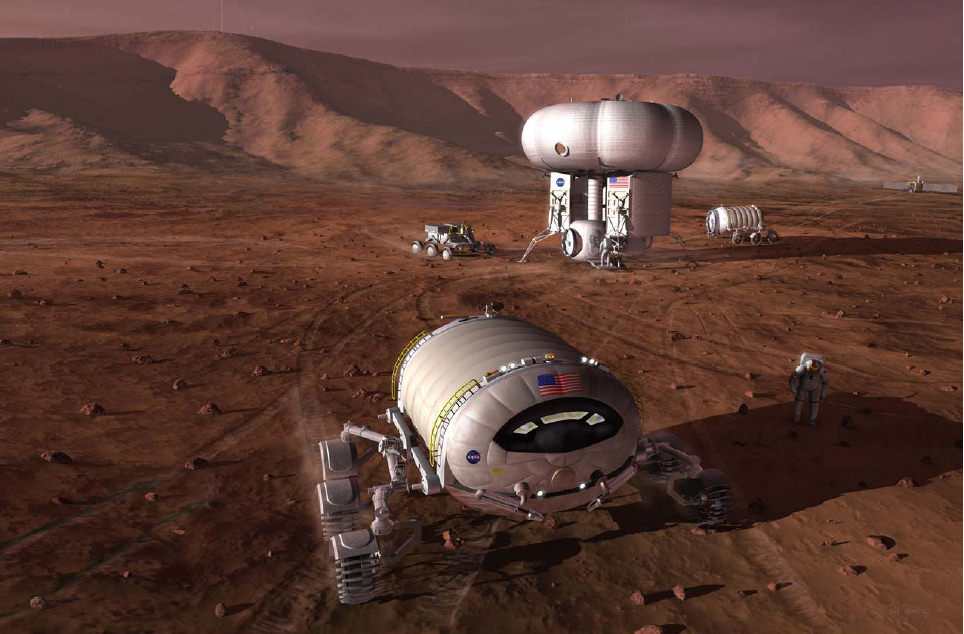
NASA just continues to push human exploration of the Moon and Mars farther and farther down the road, and nobody says a thing.
I truly, truly want to believe in the validity of the Apollo moon landings, but articles like this really make me start to doubt them.
Why is it so incredible that the political will to go to the Moon was present in the ’60s but not anymore? How does this give credence to the conspiracy theorists who think the Moon landings were staged?
There is no reason to doubt the validity of the Moon landings. For starters, in the context of the Cold War – when space exploration was also considered a matter of national security – budgets were much more amenable. And the plans are evolving, with no hard dates set. People have to work with the budgets and technology they have.
I like the idea of our astronauts landing on Phobos first and using that as a base. From there, control VR robotics working on the surface of Mars in near ‘real time’. At present, the at times long lag(s) between Earth and Mars puts severe limitations on any rover’s capabilities. Think about the crew you would need to run three shifts 24/7 for a year? What would you build on Mars?
How can we seal lava tubes so they can be pressurized? What do you think? How about inflating a form fitting bladder or sleeve that solidifies when exposed to UV? Or maybe spray the walls of the tube with water to make layers of ice? How about melting chamber(s) in a buried water ice glacier? Should the colony be located under the ice? Temp. and rad. control would be good.. eh oui?
I never understood the whole “land on Phobos first and use it as a base” angle. I guess the crux of the argument is that it’s easier to land/launch from there because you aren’t dealing with such a strong gravity well, but I could see a LOT of problems with it.
There’s no atmosphere whatsoever, the object is much, much smaller than Mars with a likely irregular center of gravity. Large parts of Phobos may be hollow, and the Soviets have always had odd stuff happen to their probes when they try to get close to it.
I like the out-of-the-box thinking, but to me, it’s far simpler and safer simply to land on Mars itself.
Where there’s a will, there’s a way.
Too bad we’re all out of ‘will.”
Nobody will go to Mars unless they have good solid reasons to. What looks probable is to send humans for sheer science. But then the Martian robots are doing a good job as of now. Just going for the novelty does not sound like an exciting goal to me.
Musk’s contention that we got to be a 2 planet species does not sound very convincing as well. I mean I understand he has to make his bucks from shuttling people to Mars. But that’s it.